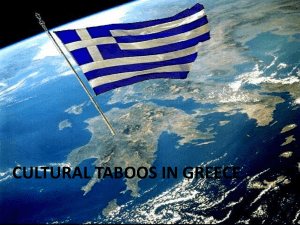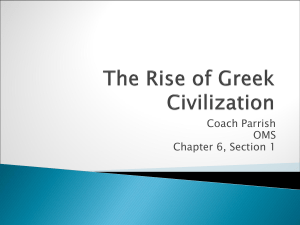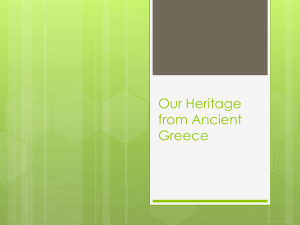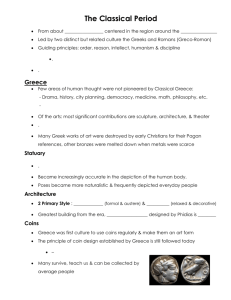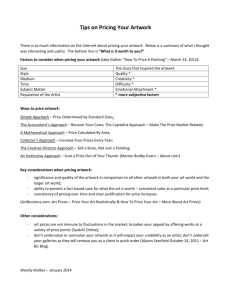Lesson Plan 2
advertisement
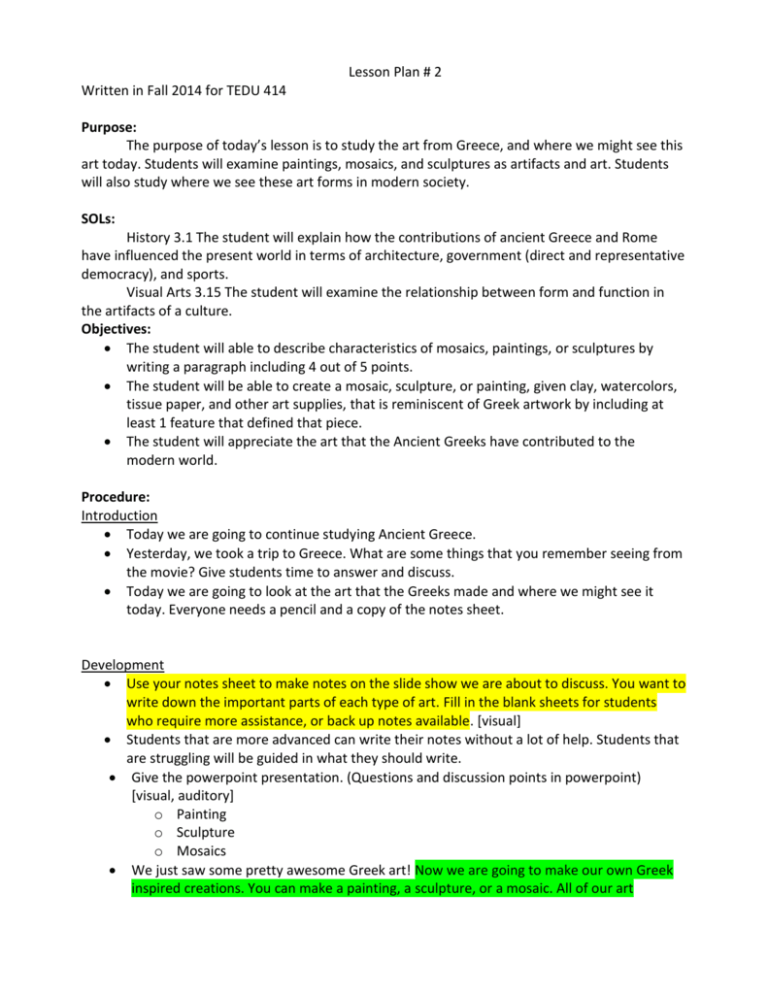
Lesson Plan # 2 Written in Fall 2014 for TEDU 414 Purpose: The purpose of today’s lesson is to study the art from Greece, and where we might see this art today. Students will examine paintings, mosaics, and sculptures as artifacts and art. Students will also study where we see these art forms in modern society. SOLs: History 3.1 The student will explain how the contributions of ancient Greece and Rome have influenced the present world in terms of architecture, government (direct and representative democracy), and sports. Visual Arts 3.15 The student will examine the relationship between form and function in the artifacts of a culture. Objectives: The student will able to describe characteristics of mosaics, paintings, or sculptures by writing a paragraph including 4 out of 5 points. The student will be able to create a mosaic, sculpture, or painting, given clay, watercolors, tissue paper, and other art supplies, that is reminiscent of Greek artwork by including at least 1 feature that defined that piece. The student will appreciate the art that the Ancient Greeks have contributed to the modern world. Procedure: Introduction Today we are going to continue studying Ancient Greece. Yesterday, we took a trip to Greece. What are some things that you remember seeing from the movie? Give students time to answer and discuss. Today we are going to look at the art that the Greeks made and where we might see it today. Everyone needs a pencil and a copy of the notes sheet. Development Use your notes sheet to make notes on the slide show we are about to discuss. You want to write down the important parts of each type of art. Fill in the blank sheets for students who require more assistance, or back up notes available. [visual] Students that are more advanced can write their notes without a lot of help. Students that are struggling will be guided in what they should write. Give the powerpoint presentation. (Questions and discussion points in powerpoint) [visual, auditory] o Painting o Sculpture o Mosaics We just saw some pretty awesome Greek art! Now we are going to make our own Greek inspired creations. You can make a painting, a sculpture, or a mosaic. All of our art supplies are ready for us. Remember when you are making you art… Why did the Greeks make this? Who or what was the subject? [kinesthetic] After you finish your artwork, I want you to write a paragraph about your piece. What type of art is it? Who or what is in the picture? Why did you pick this project? Why did the Greeks make this artwork? For students who finish early, they can choose to do another art project or to read. For students who are struggling, they will receive more teacher assistance, and their paragraph can be replaced by orally answering the questions. Summary Everyone bring your artwork over to our gallery. Does anyone want to share their art with us? Tell us a little about your piece. After students have the opportunity to share, do a class review of the three types of art and key features. o What were the three types of art? o Did the Greeks paintings look realistic or fictional? o What did the Greeks usually paint? o Why did the Greeks make sculptures? o What were some things that the Greeks made for them to use? o What did the Greeks use to make mosaics? o What was the subject (who or what) of most Greek mosaics? Great job today! Tomorrow we will continue our study of Greece. Materials needed for the lesson: Powerpoint on Art Art Notes Sheet Clay for sculptures Watercolors Paintbrushes Construction or Painting Paper Tissue paper or other paper scraps Glue Evaluation Part A: The students will be assessed by their artwork and paragraph (or verbal response). There will be 5 points available. o Did the student know which type of artwork they made? o Was the artwork representative of the Greek artwork? o Did the student state why the Greeks made the artwork? o Did the artwork contain elements that were important in Greek art (realism, function, decorative)? o Information was included about why the student chose their project.
